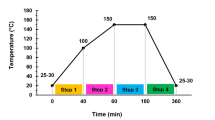The objective of this study was the production of gypsum particleboards with vine stalk waste and the investigation of some physical and mechanical properties of the boards. For this purpose, boards were made from gypsum, oven-dried mass of vine stalk waste, and the white portland cement in various ratios. The thickness swelling and water absorption after 2 and 24 hours of immersion in water, the modulus of rupture, the modulus of elasticity, and the internal bond strength of the boards were determined according to the European Norms standard. The results show that, by selecting proper ratios between the constituents, particleboards with good physicomechanical properties can be produced.





Similar content being viewed by others
Notes
International Organization of Vine and Wine
Food and Agriculture Organization of the United Nation
References
K. Doosthoseini. “Wood composite materials manufacturing and applications,” University of Tehran press, Tehran: Iran (2007).
B. H. Lee, H. S. Kim, S. Kim, H. J. Kim, B. Lee, Y. Deng, Q. Feng, and J. Luo, “Evaluating the flammability of wood-based panels and gypsum particleboard using a cone calorimeter,” Construction and Building Materials, 25, 3044–3050 (2011).
Y. Deng and T. Furuno, “Properties of gypsum particleboard reinforced with polypropylene fiber,” J. Wood Sci., 47, 445-450 (2001).
S. Kim, J. A. Kim, J. Y. An, H. S. Kim, H. J. Kim, Y. Deng, Q. Feng, and J. Luo, “Physicomechanical properties and the TVOC emission factor of gypsum particleboards manufactured with pinus massoniana and eucalyptus sp,” Macromol Mater Eng., 292, 1256-1262 (2007).
G. Li, Y. Yu, Z. Zhao, J. Li, and C. Li, “Properties study of cotton stalk fiber/gypsum composite,” Cement and Concrete Research, 33, 43-46. (2003).
International Organization of Vine and Wine, OIV Statistical Report on World Vitiviniculture. www.oiv.int/oiv/ files/0%20-%20Actualites/EN/Report.pdf. (2012).
Food and Agriculture Organization of the United Nation, Agribusiness Handbook, Grapes & Wine, www.fao.org/ docrep/012/al176e/al176e.pdf. (2009).
A. Kargarfard and A. Nourbakhsh, “Utilization of vine pruning’s residues in particleboard,” Iranian J. of Wood and Paper Sci. Research, 19, 195-174 (2004).
T. Furuno, C. Hara, Y. Deng, and S. Kato, “The improvement on the properties of gypsum particleboard by reinforcing with coir fibers,” Wood Industry, 57, 386-391 (2002).
Y. Deng and T. Furuno, “Study on gypsum-bonded particleboard reinforced with jute fibers,” Holzforschung, 56, 440-445 (2002).
W. Lei, Y. Deng, and M. Zhou, “Mechanical properties of nano SiO2 filled gypsum particleboard,” Transactions of Nonferrous Metals Society of China, 16: 361-364 (2006).
R. Espinoza-Herrera and A. Cloutier, “Physical and mechanical properties of gypsum particleboard reinforced with Portland cement,” Europ. J. of Wood and Wood Products, 69, 247-254 (2011).
EN 317. “Particleboard and fiberboard – Determination of swelling in thickness after immersion in water,” European Committee for Standardization (1993).
EN 310. “Wood based panels – Determination of modulus of elasticity and bending strength,” European Committee for Standardization (1993).
EN 319. “Particleboard and fiberboard – Determination of tensile strength perpendicular to the plane of the board,” European Committee for Standardization (1993).
ASTM C191. “Standard Test Method for Time of Setting of Hydraulic Cement by Vicat Needle,” (1999).
Author information
Authors and Affiliations
Corresponding author
Additional information
Russian translation published in Mekhanika Kompozitnykh Materialov, Vol. 50, No. 4, pp. 697-706, July-August, 2014.
Rights and permissions
About this article
Cite this article
Rangavar, H., Khosro, S.K., Payan, M.H. et al. Study on the Possibility of Using Vine Stalk Waste (Vitis Vinifera) for Producing Gypsum Particleboards. Mech Compos Mater 50, 501–508 (2014). https://doi.org/10.1007/s11029-014-9436-9
Received:
Published:
Issue Date:
DOI: https://doi.org/10.1007/s11029-014-9436-9




